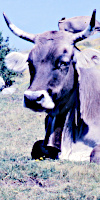This approach is generally easy
to understand.
We have a soft milk chocolate (№ 1) and the softness is further emphasized by the image of a calf. Or should that perhaps give the hint that the chocolate is particularly recommended for children? Butter comes straight from the pasture and is a
pure and natural product
(№ 2). That must be good for us.
We recognize the same thought in № 4 where
cows graze from north to south for our health
. We also learn:
Belgium [is a] country of milk and butter
not honey.
The liqueur with cream (№ 5) shows a rural scene with a church, lots of greenery and freely walking cows that are visited in the meadow to be milked manually by the farmer's wife.
It makes us melt with warm feelings full of nostalgia and with that bottle we can evoke that feeling at will.
As with grapes, there are also meat connoisseurs and they are expected in the beef bar of № 3.
The commercial lists different races and even tries a simple language joke (in English for a Dutch-speaking audience): Nice to meat you
.
Leather products usually keep it simple. They show the product with a cow next to it, and sometimes they just show the cow (№s. 6, 7).
But sometimes it is a bit more complicated
, such as in
Traveling with luggage
(№ 8).
Feeling is a monthly upscale lifestyle glossy magazine and this advert is one of series with the same person in different situations. Therefore, the luggage in question may have nothing to do with leather suitcases.
It may be about intellectual luggage provided by the magazine.
The footer of the commercial reads
Take your pleasure seriously
.
It is not clear if this is a reference to a popular tagline by the designer
Charles Eames.
Why the cow, or the octopus in another case, or this tagline? A mystery to me.




































